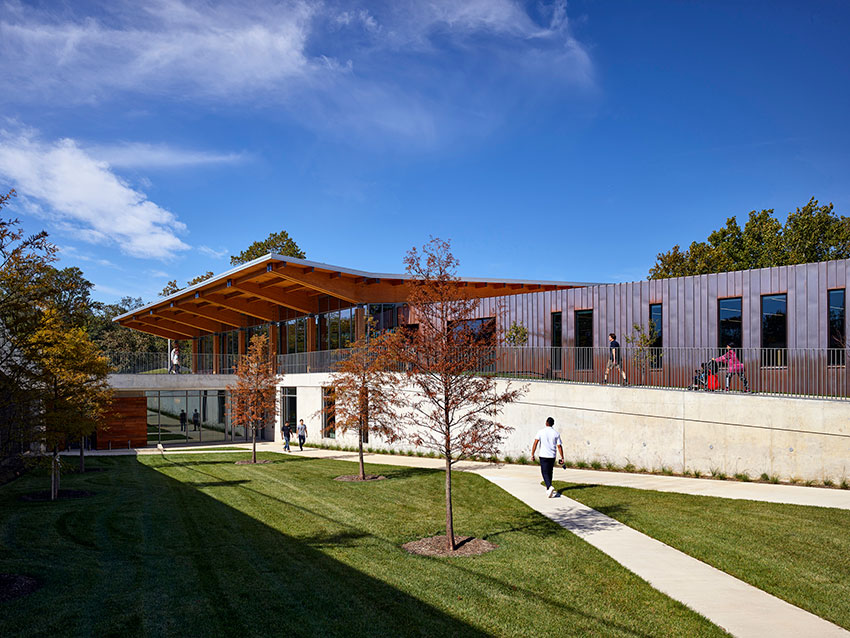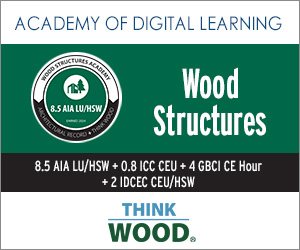Multi-Family, Mid-Rise Wood Buildings
 1 AIA LU/HSW; 1 GBCI CE Hour; 0.1 ICC CEU; 0.1 IACET CEU*; 1 AIBD P-CE; AAA 1 Structured Learning Hour; This course can be self-reported to the AANB, as per their CE Guidelines; AAPEI 1 Structured Learning Hour; This course can be self-reported to the AIBC, as per their CE Guidelines.; MAA 1 Structured Learning Hour; This course can be self-reported to the NLAA.; This course can be self-reported to the NSAA; NWTAA 1 Structured Learning Hour; OAA 1 Learning Hour; SAA 1 Hour of Core Learning
1 AIA LU/HSW; 1 GBCI CE Hour; 0.1 ICC CEU; 0.1 IACET CEU*; 1 AIBD P-CE; AAA 1 Structured Learning Hour; This course can be self-reported to the AANB, as per their CE Guidelines; AAPEI 1 Structured Learning Hour; This course can be self-reported to the AIBC, as per their CE Guidelines.; MAA 1 Structured Learning Hour; This course can be self-reported to the NLAA.; This course can be self-reported to the NSAA; NWTAA 1 Structured Learning Hour; OAA 1 Learning Hour; SAA 1 Hour of Core Learning
Learning Objectives:
- Identify the sustainability and economic benefits of using wood construction for mid-rise multi-family or mixed-use buildings.
- Summarize building code requirements and provisions for mid-rise multi-family wood-frame structures.
- Discuss wood framing solutions that address issues such as shrinkage, fire protection and seismic requirements while minimizing the carbon footprint of the building.
- Explore innovations in wood framing design techniques and wood product technologies that enhance energy efficiency.
This course is part of the Wood Structures Academy
Cost Savings, Increased ROI
Building professionals often find wood-frame structures to be more economical, for reasons including speed of construction and lower material costs. Since wood is lighter weight than other structural materials like concrete or steel, a wood structure may have lower foundation costs. Cost of wood construction can also be lowered by using prefabricated components and assemblies, which speed installation.
After completing the first phase of a five-story student housing project at Illinois State University using steel construction, OKW Architects in Chicago switched to wood for the remaining phases. “Because the structure had so many openings, the metal studs for the first building, Flats on Main, needed to be 12-gauge, but they were heavy and it was difficult for the crews to screw and attach our finishes. So, the contractor encouraged us to switch to wood bearing walls for Flats on Osage, the second building. As a result, it ended up being a more economical project,” said OKW’s Eileen Schoeb.
1430 Q, a multifamily, mixed-use development in Sacramento, California, is another example of how wood was used to improve the return on investment for a mid-rise project. The developer collaborated with WoodWorks and a code consultant to file an Alternate Means and Methods Request (AMMR) with the City of Sacramento, which gave its approval for six and a half stories of wood, including the top-level mezzanine, over a two-story podium. This allowed more tenants and more lease income from the one- and two-bedroom apartment complex. It also allows the developer to realize premium rents for the top floor view units. When it was completed, 1430 Q was the first residential building in the U.S. to be constructed using a 6.5-over-2 building configuration and the country’s tallest light-framed wood building.
Code-Compliant, Marketable Structures
Design professionals familiar with wood construction for two-to-four-story residential structures may not be aware that the Table 504.4 of the 2021 International Building Code (IBC), Allowable Number of Stories Above Grade Plane, allows up to five stories of Type III wood-frame construction for residential occupancies and six stories for business occupancies. Type V buildings have a maximum of four stories.
Designers can also use concrete podiums under wood-frame construction to add additional stories. Table 510.2 limits the height above grade to the most restrictive building’s normal height, though additional stories can be fit within that height-above-grade restriction. For instance, a Type VA of a 1-A podium can have two stories of 1-A plus four stories of VA as long as the VA building does not exceed 70 feet above grade (sprinklered), its normal height-in-feet limit.
Since the 2009 edition, the one-story limit for the 1-A lower building was removed but the upper building still cannot exceed height above grade for its construction type, as noted above. This means developers can build four or five stories of wood over a single- or double-level podium (which would be referred to as a 4-over-1 or a 5-over-2).
Mahlum Architects worked with engineers at Coughlin Porter Lundeen to design five buildings of student housing for the University of Washington. They made the most of the urban campus location in Seattle, designing each of the buildings with five stories of light-frame Type V-A wood construction over a two-story Type I-A concrete podium. This approach helped them meet code requirements, ambitious design goals and the university’s tight budget. The 668,800-square-foot project, completed in 2011 and 2012, was constructed for $177 per square foot. Building codes are meant to be material neutral, which means that mid-rise wood-frame buildings are required to meet all the same safety and performance requirements as a similar building made from any other material. With the assurance that wood meets code, building owners and designers often use wood because of its cost benefits. Wood buildings can usually be constructed more quickly, which helps developers increase the return on their investment through earlier completion. Wood’s versatility, sustainability, and aesthetic attributes help make it a desirable choice for many design teams.












